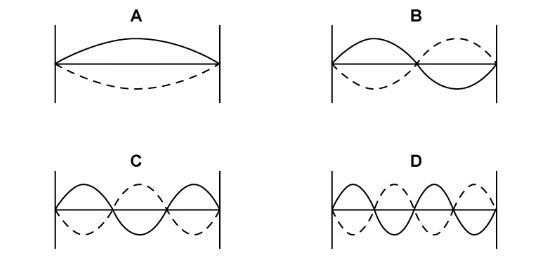Identify the line which makes up a correct description of the conditions for superposition.
| A. |
One wave |
travelling in water |
with a constant speed |
| B. |
Two waves |
travelling in opposite directions |
with the same frequency |
| C. |
Two waves |
travelling near each other |
with the same frequency |
| D. |
Three or more waves |
travelling in the same direction |
with different frequency and speed |
For the two waves shown, identify the correct possible result after they superpose.

Identify the pair of statements which both correctly describe properties of standing waves.
- All points have the same amplitude in turn
- Points which are one wavelength apart are in phase
- Each point has a different amplitude
- Points between nodes are in phase
- All points have the same amplitude in turn
- Points between nodes are in phase
- Energy is moved from one point to another
- The wave has nodes and antinodes
For the wave shown, how many nodes, and how many anti-nodes are present?

| |
Nodes |
Anti-nodes |
| A. |
2 |
6 |
| B. |
2 |
3 |
| C. |
4 |
6 |
| D. |
4 |
3 |
The diagram shows a stationary wave. Which line correctly identifies the labelled sections?

| |
P |
Q |
R |
| A. |
antinode |
node |
length of string |
| B. |
node |
antinode |
wavelength |
| C. |
node |
antinode |
frequency |
| D. |
wavelength |
wavelength |
length of string |
A stationary wave is formed in a pipe which is open at both ends.
Which statement must be correct?
Nodes form at the ends of the wave.
Antinodes form at both ends of the wave.
Displacement is a maximum at the nodes.
Displacement is at a minimum at the antinodes.
A stationary wave forms on a string of length L. Which harmonic has a wavelength where λ =  ?
?
Which diagram shows the first harmonic on a string?

Which is the correct general equation for the wavelength of the nth harmonic in a pipe of length L which is open at one end?







